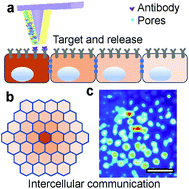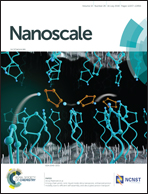Single-cell membrane drug delivery using porous pen nanodeposition†
Abstract
Delivering molecules onto the plasma membrane of single cells is still a challenging task in profiling cell signaling pathways with single cell resolution. We demonstrated that a large quantity of molecules could be targeted and released onto the membrane of individual cells to trigger signaling responses. This is achieved by a porous pen nanodeposition (PPN) method, in which a multilayer porous structure, serving as a reservoir for a large amount of molecules, is formed on an atomic force microscope (AFM) tip using layer-by-layer assembly and post processing. To demonstrate its capability for single cell membrane drug delivery, PPN was employed to induce a calcium flux triggered by the binding of released antibodies to membrane antigens in an autoimmune skin disease model. This calcium signal propagates from the target cell to its neighbors in a matter of seconds, proving the theory of intercellular communication through cell–cell junctions. Collectively, these results demonstrated the effectiveness of PPN in membrane drug delivery for single cells; to the best of our knowledge, this is the first technique that can perform the targeted transport and delivery in single cell resolution, paving the way for probing complex signaling interactions in multicellular settings.



 Please wait while we load your content...
Please wait while we load your content...